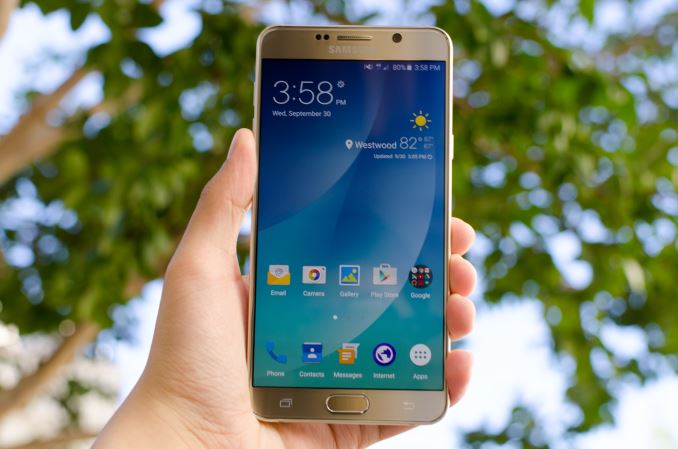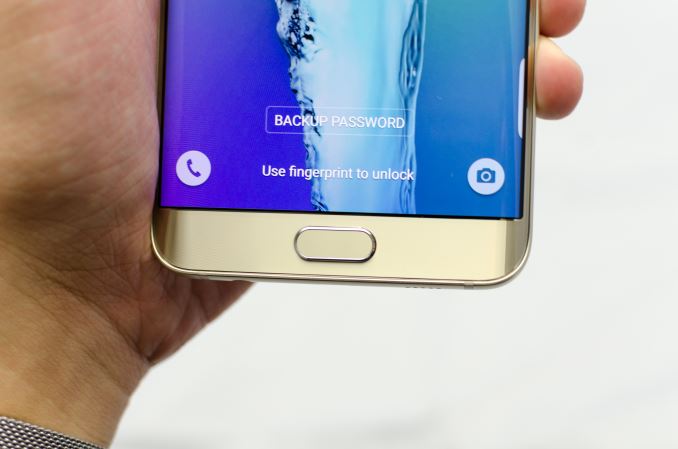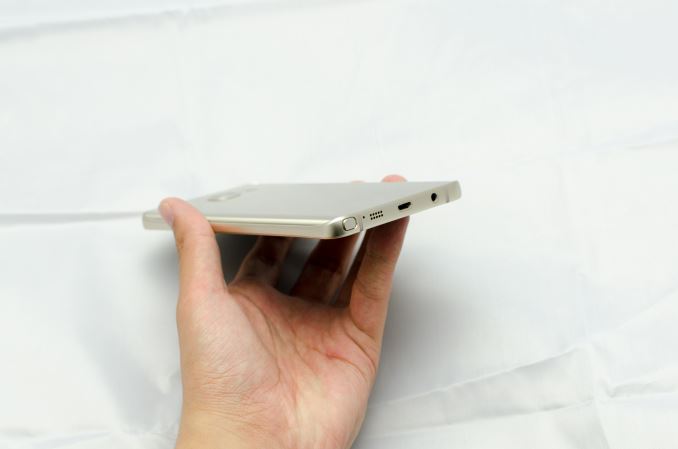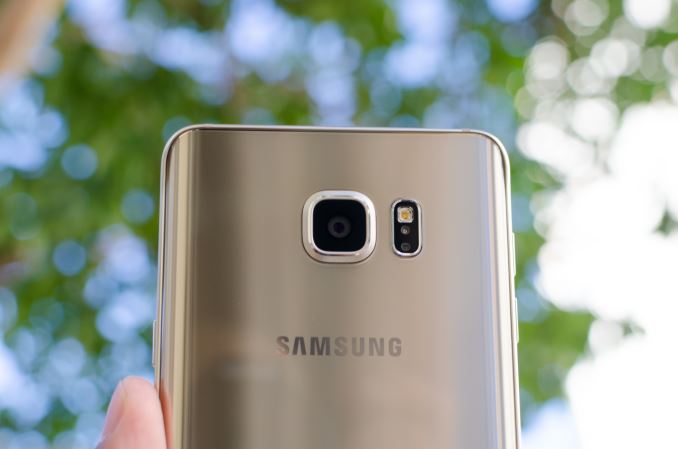The Samsung Galaxy Note5 and Galaxy S6 edge+ Review
by Joshua Ho on October 2, 2015 8:00 AM ESTFinal Words
The Galaxy Note5 is a bit of a break in form for Samsung, but in some ways it represents a return to form. To understand what this means, we can look at the various aspects that make up the Galaxy Note5 in contrast to the Galaxy S6. One of the easier places to start is the design, which shares a great deal in common with the Galaxy S6. We see a similar reflective coating under the glass, a glass back cover, an aluminum midframe, and the usual home button and thin bezels. The fingerprint scanner in the home button works about as well as you would expect and is comparable to the Galaxy S6.
The next aspect of the phone worth looking at is battery life. Here, we see that the Note5 gets a healthy bump in battery life relative to the Galaxy S6. Relative to the Note 4, battery life is basically comparable and not all that different. It seems that Samsung’s theme this year is maintaining battery life by reducing battery size and improving power efficiency. Those looking for a removable battery might be disappointed, but if you never swapped the battery in a phone like the Galaxy Note 4 there’s nothing to really worry about here. Samsung has also retained fast charging capabilities, so it isn’t nearly as important to swap batteries.
The display of the Galaxy Note5 continues to be incredible. Out of all the Android OEMs right now, Samsung is the best at display. I’m still of the opinion that the best LCDs are comparable with Samsung’s latest AMOLED panels, but within the next year or two I’m fairly confident that they won’t have any competition here. However, given the lack of second source suppliers it seems unlikely that OEMs will move en masse to OLED as strongly relying on a single supplier for any critical part of a product could easily be a disastrous mistake. The Galaxy S6 edge+ has a similar level of display quality, but the edges of the display are clearly distorted to the eye due to the subpixel arrangement used.
The SoC used continues to be the best SoC you can get in any mobile device running Android. This is likely to change next year, but given the data it’s incontrovertible that the Exynos 7420 is the fastest and most efficient SoC available in an Android device. These two factors strongly affect user experience in workloads like web browsing, updating and installing apps, and gaming. If you do any of those three things, SoC performance has a strong influence upon overall user experience for you. NAND quality isn’t quite at the same level as the Galaxy S6, but it’s more than sufficient and is unlikely to be a problem for the duration of a two year contract.
Overall, the software experience is actually quite acceptable. TouchWiz has gotten a lot better in the past generation, and any time I pick up a Galaxy S3 or Galaxy S4 I’m immediately reminded of this. However, as mentioned in the Galaxy S6 review I don’t think it’s necessarily perfect. The smoothness of the UI isn’t as amazing as some of the phones I’ve used in the past, and there are sometimes odd choices in application design like icon design. Using a Material Design theme from the theme store goes a long way to dealing with this problem, but that’s no excuse for the default theme. The Note features are useful and the single biggest reason to buy the Galaxy Note5 over another phablet, but the edge features are decidedly impractical and generally not very useful. I still think it's possible to make a better skin than TouchWiz, but I can live with TouchWiz on a primary phone.
In the camera department, on the surface nothing has changed relative to the Galaxy S6. Even if Samsung didn’t do anything for the Galaxy Note5’s camera relative to the Galaxy S6, it would still be one of the best Android cameras you can get today. However, Samsung has included a number of new features like RAW capture and improved manual mode controls. In addition, they’ve dramatically improved low light photo processing to the point that I’m confident in saying that the Galaxy Note5 beats the LG G4 and iPhone 6 Plus, but in video performance the iPhone 6 Plus is still slightly better. The Galaxy Note5 is either as good as or better than the iPhone 6 Plus for overall camera quality depending upon how strongly you want to weight video recording.
Outside of these main areas of focus, overall I like the the Galaxy Note5. In chosing to mimic the Galaxy S6 so closely it's not a bold design for Samsung and you won't find much in the way of new features, but instead what you get is in many ways a big Galaxy S6. Often because of that it's not a perfect phone - Samsung could still afford to work on polish, particularly in regards to issues like inserting the stylus backwards or RAW files that aren’t deleted - however it also does a lot well like the 5.7" SAMOLED display, the camera, and the Exynos 7420 SoC.
If you’re looking for the best Android phablet on the market today the Galaxy Note5 or Galaxy S6 edge+ is likely to be your best bet. They may not be a big jump up from the Galaxy S6, but they're still the best Android phablets you can get today. In that sense, Samsung is departing from the sort of strategy that we saw with the Galaxy Note 3 and 4 in the form of a new SoC and other improvements that came with the Note line, but like the Galaxy Note 1 and 2 these are phablet variants of their Galaxy S cousin.















225 Comments
View All Comments
The0ne - Friday, October 2, 2015 - link
WTF, so you want him to voice on something that doesn't exist then? That's just stupid. I bet you use this argument all the time to feel good about yourself. lol. Be easier if you just tell him to not bother in your little fight at all. Makes much more sense.Sttm - Friday, October 2, 2015 - link
Go cry about your real world problems and leave the comments sections of a tech site to us! I'm sure there is a starving kid somewhere that can use your tiny violin services.The0ne - Friday, October 2, 2015 - link
He's not crying, he's laughing at you and the other people bitching about the two companies RATHER than enjoying the devices. You totally misunderstood and misinterpreted his comment. Tech sites needs smart people, please just leave. Take your fanboy arguments elsewhere.And thanks for sharing something a little about your selfish self, all from your stupidity.
melgross - Saturday, October 3, 2015 - link
Oh, shut up!kspirit - Saturday, October 3, 2015 - link
No. >:(generalako - Saturday, October 3, 2015 - link
A more recognized source is the industry standard DisplayMate. Take a look at their tests of the newest Samsung flagships. Ever since the S5, they have been leading in the mark, and ever since the Note 4, their displays have been "considerably better" than the best LCD display (iPhone 6) out there, on virtually every category (contrasts, black levels, efficiency, color accuracy, brigthness, performance in bright lights, viewing angles, sharpness, etc.)http://www.displaymate.com/Galaxy_Note5_ShootOut_1...
Anandtech's test is hard to take seriously when they can't even rate the true peak brigthness of the Samsung phones. They don't even mention that they have left it out of their test! When put on auto brigthness, the Note 4, S6 and Note 5 all get far higher brightness than on manual. The Note 5 can reach 861 cd/m2. That's 50% more than Anandtech claim.
Take a look at DisplayMate's review. They give a proper analysis of the display, which contradicts the Anandtech review on so many areas it's funny.
Peichen - Monday, October 5, 2015 - link
DisplayMate is a Samsung marketing partner. I wouldn't trust it consider them never mention the lackluster AMOLED sub pixel arrangement.MattL - Saturday, October 10, 2015 - link
What the hell are you talking about... first of all read the DisplayMate Samsung review again and search for "Diamond" where they outline the Diamond sub-pixel arrangement. They also have a completely separate article detailing this arrangement (including a zoomed in picture):http://www.displaymate.com/Diamond_29.html
Also in the review in their spec lists they list the sub-pixel count so you can fully compare resolution and sub-pixel counts... hell for their distance in which 20/20 vision can be resolved by the human eye they include stats for the different subpixel counts (which are different per color based on the Diamond arrangement).
How you missed all that I have no clue other than you didn't bother to actually read it.
Also on your first point, Displaymate has been a leader in screen calibration for a long time now... this is their specialty and not the speciality of Anandtech, hence why people take them far more seriously on that topic... it's also why it's a bit surprising Anandtech keeps coming up with different (and less detailed) results, especially when Anandtech doesn't include important values and analysis)... You should really know what you're talking about before you make such a bold response.
Also Displaymate rates the iPhone screens *very* well, just not as a good as Samsung for the past couple generations. You do realize of course that Apple sources their screen manufacturing from a variety of companies... including Samsung, so it makes complete sense that Samsung is doing better when they finally decided to put the resources into it.
Kamus - Sunday, October 4, 2015 - link
On par? You do realize that a Delta below 3 is very much unnoticeable when it comes to gamut and grayscale calibration right?This means that even the galaxy note 4 display smokes any iPhone display to date, because EVERY LCD that has ever been made has downright comical contrast ratio. And OLED on the other hand has the end game in contrast, as in, its perfect.
The only reason this isn't more obvious is because most of the content viewed in smartphones is bright and viewed in very bright environments. Which sort of gives LCDs a free pass since its contrast ratio deficit isn't as obvious as in those situations.
You should know that videophilies spend thousands of dollars on displays that offer even slightly better contrast ratios. And here we have a situation where we go from terrible contrast, to perfect. Watch any sort of dark content on both displays at the same time in a light controled environment and you'll immediately see how these Samsung displays are simply in a whole different league.
Then there's is also the fact that the color gamut is also much wider on OLED, so if the day ever came that we finally decide to stop using the obsolete sRGB standard, OLED would also have an advantage there. (Somethg that had been ironically seen as a disadvantage before they started shiphing phones with color profiles, because the gamut is so wide it results in over saturated colors if a profile isn't is used for sRGB)
I also have to question the brightness results that anandtech got from their unit. Displaymate stated that this is the brightest smartphone display they have ever tested, they get over 800 Nits on their unit. Making it by far the best display you can use under the sun.
To meet it seems obvious that LCD has been surprised in most meaningful metrics, and its only going to get worse for LCD as OLED continues to evolve. LCD has never been good enough, but as it matured it got to a point where it became really good in a lot of ways compared to CRTs (never in contrast or switching times)
TL;DR: these Samsung displays are the benchmark every other display has to be compared to.
thedons1983 - Sunday, October 18, 2015 - link
Yeah, but it's made by Apple, and is pretty much exclusively sold, therefore, to sheep, whom generally have no idea what they are talking about. I'd rather not have a smartphone at all, than one of those ugly ass iphones. But then, that's probably because I actually have taste, and don't just buy whatever hipster rubbish is currently en vogue.